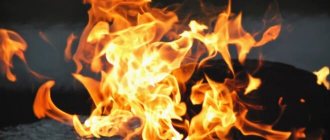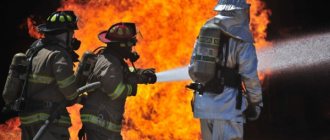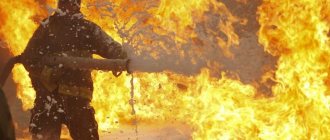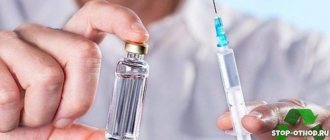The first thing people try to put out a fire is water. In most cases, it is enough to pour flame into it to extinguish the fire.
But there are solid and liquid materials, when extinguishing which it is impossible to use not only water, but also compositions based on it.
What types of fires exist, the stages of their development and methods of localization. Substances and materials when extinguishing which it is dangerous to use water. Regulatory documents regulating the use of fire extinguishing agents.
Methods for localizing fires
Depending on the materials involved in the combustion and the area covered by the flame, a means of extinguishing the fire is selected.
At the initial stage, primary fire extinguishing devices are used. When using a fire extinguisher, it is important to understand the class of fire and whether the extinguishing agent can be used.
Extinguishing with a powder fire extinguisher
In production areas, it is necessary to check the operation of the fire extinguishing system. If the protective devices do not connect automatically, they must be started manually.
It is very important to report the detected fire to the fire department, and then proceed to localize the flame yourself. To do this, it is permissible to carry out the following activities:
- mechanical fire extinguishing;
- blocking the supply of oxygen to the fire zone (sand, earth, fire blanket, fire extinguishing agents);
- isolate combustible and flammable materials and liquids from fire;
- dilute flammable mixtures with compounds or compounds that are not subject to flame.
For each type of fire, specific fire extinguishing compounds are used.
Fire-fighting equipment
To eliminate fires of various classes, special substances are used:
- water or water-based foam for Type A fire;
- powder, foam compositions for class B;
- flame retardants, powder, carbon dioxide for C;
- special powder compositions for type D;
- freons, carbon dioxide, fine powders for type E fires.
Different types of fire extinguishers
Fire extinguishing efficiency of water
To the question “What are the fire extinguishing properties of water?” I can't answer briefly. A comprehensive study of water as a substance is required. This OTV has the following properties:
- Heat capacity. This means that when water gets into the source of fire, it takes away some of the heat from the fire to evaporate, providing a cooling effect.
- Low thermal conductivity. Water cannot catch fire or heat up quickly from an external source.
- Thermal resistance. Water vapor breaks down into its components (oxygen and hydrogen) only at temperatures above +1,700 ℃.
- Low viscosity. The substance is liquid, which allows it to be used and transmitted through hose lines under pressure.
- High volume of vaporization. When evaporating, the volume of water increases by more than 1,000 times. Thus, the air in the combustion zone is diluted with steam. Water vapor displaces oxygen and isolates the source.
Types of fire extinguishing agents:
Used for extinguishing wood, paper, and textile products. Flammable substances that are insoluble in water are extinguished by adding fluorinated surfactants to the water. Water can also be used to cool flammable equipment.
A universal extinguishing agent for fires of various classifications.
Used to extinguish liquid flammable substances. A fire extinguisher filled with carbon monoxide is ideal in this case. Another significant advantage is that the composition of such a fire extinguisher does not damage extinguishing surfaces (household items, paintings, electronics, laboratory equipment, etc.).
4. Fire box for sand.
This type of equipment is intended for storing sand and using it in case of a fire caused by a short circuit in the electrical network. Before extinguishing such a fire, you should first turn off the power to the building! Here it is advisable to use a halon fire extinguisher.
Buying a fire extinguisher in Chelyabinsk at an affordable price is very simple. To do this, you need to contact. After all, the cost of a fire extinguisher does not take into account any losses that may result from a spreading fire.
Ways to increase the fire extinguishing efficiency of water
Water does not wet materials well due to high surface tension. To reduce it, special additives are used:
- Thickeners. Increases the viscosity of water.
- Foaming agents. You can get foam from solutions of this product using a special nozzle.
- Surfactants.
Modular foam fire extinguishing system
conclusions
Despite the fact that there are methods and rules for extinguishing fires, there are a huge number of factors that complicate the work of the fire department.
One of these problems is extinguishing class B1, E, D fires with water, which leads to an increase in the area covered by flames, explosions, etc.
When designing production facilities, technological processes and substances used are taken into account, which reduces the likelihood of chemical reactions occurring between the fire extinguishing mixture and burning materials.
To reduce the risk of household fires, it is necessary to conduct preventive training for the population, explaining how to act if a fire occurs, and how important it is to have a supply of water and fire extinguishing agents at home.
Attention! Burning oil!
You need to be even more careful with burning oil than with other products.
And here’s why you can’t put out burning oil with water: let’s get creative. You can imagine this situation: a frying pan with a large amount of vegetable oil was forgotten on the fire. First, the oil will heat up, then it will begin to boil, but at a temperature of 232°C the oil will begin to smoke, after which a fire will occur. The flame will simply blaze in the frying pan.
If you splash water onto the frying pan at this time, the situation will only worsen - the water (since it is lighter than oils) will immediately fall to the bottom, where it will instantly heat up and begin to boil, and at the same time, during boiling, the water will throw burning oil out of the frying pan onto long distance.
Not only will people nearby be seriously burned, but the fire will also be sprayed, increasing the area of the fire.
When is the water suitable for extinguishing?
At enterprises and other industrial facilities, this issue is resolved at the stage of development of technological processes. When designing fire protection systems, the specifics of production are taken into account and the list of raw materials used is studied. In accordance with the research carried out, acceptable primary fire extinguishing means and automatic installations are determined.
The most in demand are systems with water supply and hydrants in warehouses, woodworking enterprises, educational, social and medical institutions where class A fires predominate.
Firefighting at a timber warehouse
At home, few people prepare in advance for unusual situations. In apartments and modern country houses, water is always available, which can be used to extinguish fires. Dachas must be equipped with a specialized water barrel.
In multi-apartment buildings, fires are most often classified as type A. Because mostly solid objects, both prone to smoldering and not, ignite.
If there is no water supply system, there should be containers filled with water near wooden buildings, sawmills, and woodworking warehouses that can be used to extinguish the fire. Under normal conditions, they can stand without use for the entire fire period. There is often a temptation to spend their contents on watering, hygiene devices, washing dishes, tools, and laundry.
But this is strictly prohibited. To the question whether it is possible to use the water supply for fire extinguishing for household purposes, there is one answer - a categorical no.
Fire stages
In any fire, three main stages of its progression can be distinguished.
The first (initial) phase is divided into two stages:
- formation of a source and development of a fire;
- increasing the area of fire, capturing territories.
During the second stage, the flame spreads throughout the entire volume of the room. The temperature reaches 300 degrees or more. The fire no longer spreads linearly, but in jumps. Ignition occurs from thermal effects, flying sparks, and objects remote from the source ignite.
If a fire occurs in a building, then at this stage the glass breaks, the flow of oxygen increases, intensifying the fire. After thirty to forty minutes, maximum parameter values are reached and combustion stabilizes.
In the third phase, after the fire load has burned out, the flame dies out and develops into smoldering. After some time, the process stops.
Extinguishing oil tanks
Interesting Facts
Facts are stubborn things! But this collection of facts on the topic of fire safety will not get your children bored. Why!? Do not agree!? Take a look through them and we think you'll agree. And since children are inquisitive people and ask a lot of “why?” and “from what?!”.. And adults do not always have a logically correct explanation for such questions, then this selection of material can be of great help.
1. Why can’t you run if your clothes catch fire? You can't run - the flames will flare up even hotter! Try to quickly throw off your burning clothes, it’s good if there is a puddle or a snowdrift nearby - dive in, if there are none, fall to the ground and roll until you knock out the flames. Another possibility is to throw any thick fabric (coat or blanket, etc.) over yourself, while leaving your head uncovered.
2. Why shouldn’t water be poured over burning oil in a frying pan? Do not pour water into burning oil, because There will be violent boiling, splashing of burning oil, burns of hands, faces and many sources of combustion.
3. Why shouldn’t electrical appliances be left unattended? Electrical appliances connected to the network, especially such as electric irons, electric stoves, heaters, cannot be left unattended, because fire is possible.
4. Why you can’t use matches and electricity. switches when you smell gas? The slightest spark or source of open flame (match, lighter...) can lead to an explosion and fire.
5. Why should you not leave cooking food on the stove unattended? Oils and fats can catch fire due to boiling over or heating.
6. Why should aerosol cans not be stored in the sun? In aerosol cans, the gas is under pressure and when heated in the sun or near an open fire (stove), it expands, which leads to an explosion and fire.
7. Why shouldn’t you throw burning airplanes from the balcony? They can fly into open windows and balconies and cause a fire.
8. Why shouldn’t you hide under a bed or in a closet during a fire? Firefighters will not be able to find you and you will suffocate from smoke.
9. Why can’t you use the elevator during a fire? In the event of a fire, the elevator will be turned off (due to a blackout in the house). So you might end up trapped and suffocate.
10. Why can’t you open windows in case of fire? There will be an influx of air (draft) and the fire will become larger.
11. Most people injured in a fire die not from burns, but from suffocation or carbon monoxide poisoning. The stronger the concentration of carbon monoxide, the faster it leads to a person’s unconsciousness, poisoning by combustion products and death.
12. Why are trams and trolleybuses dangerous in case of fire? Electric shock, so do not touch metal parts in a trolleybus or tram - in the event of a fire, they may become electrically charged.
13. Why is a bus dangerous in case of fire? Explosion of a gasoline tank, therefore, after leaving the bus, you need to move to a safe distance - 25-30 m.
14. Glass shards are a fire hazard. In sunny weather, these fragments focus the sun's rays like incendiary lenses.
15. Why don’t they store waste paper and old things on the balcony? If a cigarette thrown from above flies onto the balcony and hits flammable objects, it will ignite and cause a fire.
16. Why is panic during a fire dangerous? Incorrect actions, because a calm person acts quickly and deliberately.
17. Why do you need to crawl when there is smoke? Smoke is lighter than air, so its concentration is lower near the floor.
18. Why do they place a metal sheet in front of the oven door? When the oven door is open, sparks and embers can fly out, which, if they hit the floor or a rag, can cause them to ignite.
19. Why are gas cylinders not stored in the house? Gas cylinders are a source of potential explosion and fire hazard.
20. Why don’t they cover the email? paper or fabric lamps? A fire may occur because within 30-40 minutes after switching on, it heats up to a temperature of 110-250 0C.
21. Why can’t you plug many electrical appliances into one outlet at the same time? Electric heating devices have a large power consumption, so you cannot simultaneously connect several such devices to one outlet - this can cause excessive heating of the wires, destruction of their insulation, melting and fire of the outlets.
22. Why is fire dangerous? Fire hazards include flames and sparks; heat flow; increased ambient temperature; increased concentration of toxic combustion and thermal decomposition products; reduced oxygen concentration; reduced visibility in smoke.
23. Why don’t they carry firecrackers in their pockets? They can spontaneously explode and thereby cause damage to physical health (wounds, burns, etc.).
24. Why can’t firecrackers be launched from the balcony? Firecrackers should not be launched from the balcony to avoid them hitting the windows and balconies of nearby buildings.
29. Why shouldn’t you touch switched-on electrical appliances with wet hands? Water passes current through itself. This is life-threatening.
25. What should you do if there is a fire in your apartment? Leave the premises and call “01” or cell phone “112” and report the address of the fire, your name, what is burning and where.
26. How can you put out a fire? Water, sand, soil (from a flower pot), washing. powder, blanket, coat, fire extinguisher.
27. Why is the fire truck red? To be seen from afar. Red color attracts attention.
28. What is the main rule in any danger? Don't panic, don't lose your composure.
30. Why is a sparking electrical wire dangerous? Violation of the insulation of an electrical wire can lead to electric shock, and damage to the current-carrying conductor can lead to sparking and fire.
31. Why are the buckets on the fire shield made of a cone? This is not due to the fact that it prevents those carrying water to the fire from stopping for a break, but because it is easier to scoop up and throw out water with a cone.
32. Why, when calling the fire department, must you immediately give the address, and then everything else? A car will be sent to the address immediately, and the dispatcher will transmit the rest of the information to the crew via radio.
33. What blanket can be used when extinguishing an electrical fire? Any dense fabric will do, including a padded jacket, but only made from natural fabrics, since synthetics melt and release acrid smoke.
34. Why shouldn’t the wires be pinched by doors or chair wheels? The small veins that make up the wire are damaged and a short circuit occurs.
35. How long does it take for a room in a block (panel) house to burn out? In about 10-15 minutes, so it is important to call the firefighters in time.
36. How often should powder fire extinguishers be checked and recharged?
Once every 5 years.
37. In what year was the decision made to create rescue services in Russia? In 1990, the Russian Rescue Corps was created as a State Committee, and in 1994 it was transformed into the Ministry of Emergency Situations of Russia.
38. What ancient but well-studied natural emergency is accompanied by fires and ash? The destruction of the ancient Roman city of Pompeii as a result of the eruption of Vesuvius in the 1st century AD.
39. What award did the Moscow Fire Department receive during the Great Patriotic War? The Moscow Fire Department was awarded the Order of Lenin for its heroic work in extinguishing fires during the Second World War.
40. Which department did the Fire Department belong to before the creation of the Ministry of Emergency Situations? Before the creation of the Ministry of Emergency Situations, fire protection belonged to the Ministry of Internal Affairs.
41. What should be done in case of a 2nd degree burn with the appearance of blisters? Cool under running cold water, then apply a dry sterile bandage and transport to a medical facility.
42. Is it possible to set fire to last year’s grass? This is not possible, as the fire can spread and cause a fire, and also harms perennial plants and insects living in the ground, including bumblebees.
43. What is the name of the state regulatory document that explains how to avoid a fire? Fire safety rules.
44. What groups are fires divided into depending on what is burning? For classes designated by the Latin letters ABCDE.
45. What is the principle of operation of a powder fire extinguisher? The powder falls on the burning substance, sinteres and isolates it from the flow of air oxygen.
46. What is the principle of operation of a carbon dioxide fire extinguisher? The flame extinguishing effect is achieved in two ways: by lowering the temperature of the fire source below the ignition point, and by displacing oxygen from the combustion zone with non-flammable carbon dioxide - liquefied carbon dioxide.
47. What is the main difference between self-activating fire extinguishers? They react to an increase in air temperature to a certain current, after which the fusible fuse is destroyed.
48. Is it possible to use a fire extinguisher to put out a fire on a person’s clothing? You can’t, you can cause chemical burns and worsen the healing of thermal burns.
49. What to do if the room begins to fill with thick acrid smoke? Cover your nose and mouth with a wet handkerchief and move towards the exit, pressing yourself to the floor.
50. In what year was the “Order on City Decoration” adopted? In 1649, on the initiative of Prince Alexei Mikhailovich Quiet
51. After what year did they start building fire towers in Russia? After 1803. On November 29, 1802, a Decree was adopted on the organization of a permanent fire brigade of 786 internal guard soldiers in St. Petersburg at the meeting yards. In the spring of 1803, the team was formed. In Russia, construction of special buildings for the fire brigade has begun.
52. Why do firefighters encourage growing indoor plants? Where there are plants, there are always containers of water for watering, and the soil can be used to extinguish small fires.
53. Why do firefighters not approve of trees on lawns under building windows? Trees interfere with the installation of fire escapes.
54. What work needs to be carried out in the forest constantly to prevent forest fires? Clearing dead wood and digging fire ditches.
55. What are the fire hazards of draining swamps? Peat fire.
56. What types of forest fires exist? Grassroots – when dry litter, bushes, and dead wood burn. Horse - when dead trees burn, and then living trees.
57. If you are cut off by fire in an apartment on the fifth floor and there is no telephone, what should you do? Plug the cracks in the doorway with wet towels and sheets, reducing the flow of smoke, and call for help through the window.
58. Why shouldn’t you throw aerosol cans from household chemicals into a fire? They are explosive.
59. What disaster occurred on April 26, 1986, where firefighters were the first to show their heroism? Disaster at the Chernobyl nuclear power plant.
60. Where should primary fire extinguishing equipment be located in a parking lot, in a village, at a gas station, in garages? Primary fire extinguishing means must be located on the fire panel.
61. What fire extinguishers are used to extinguish fires in archives, libraries, and museums? Carbon dioxide. They do not spoil (they do not wet like water ones, do not corrode like foam ones and do not stain like powder ones).
62. What do people suffer more often from in a fire: smoke or fire? From smoke, because poisoning by combustion products occurs, loss of visibility.
63. How many days did the fire in Moscow last during Napoleon’s invasion?
5 days
64. What is the motto of firefighters in Rus'? “Praise to God, protection to neighbor”
65. What is the most important rule in the event of a fire? Do not panic and call “01” or “112”.
66. Why are firefighters called fire fighters? Every day he fights with fire, in which people can die.
67. What to do if the iron catches fire? 1. Turn off the electricity! 2. Cover with a heavy cloth and press tightly to prevent air from entering.
68. What is the name of the tip on the fire hose that directs the water jet? Fire hose or fire barrel.
What cannot be extinguished with water
Three main groups can be distinguished:
- All liquid oil-containing products (kerosene, gasoline, etc.).
- Devices and equipment under voltage.
- Compositions that react chemically with water.
Substance or material and the result of exposure to water
We present a table in which we indicate several different compositions that produce a fire hazardous response as a result of chemical interaction with water.
| Name | Reaction summary |
| Bitumen | Drops splash, combustion intensifies |
| Lead nitrogen compounds | Explodes when humidity increases to 30% |
| Aluminum carbide | Releases flammable gases, explodes on contact with water |
| Sodium peroxide, potassium peroxide | Intensify the fire, explode |
| Cesium, potassium, sodium | Produces hydrogen, which ignites as a result of the release of thermal energy during the reaction |
| Sesquil chloride | Explosion |
| Calcium peroxide | Releases oxygen, which intensifies combustion |
This table clearly shows why it is impossible to extinguish a fire with water without determining which compounds are engulfed in flames.
Bitumen
In everyday life, a common cause of fire is vegetable or animal fats that ignite during the cooking process. In this case, it is very important to understand why you cannot extinguish the stove with water. Oil is lighter than water and when it is fed into a container, it sinks to the bottom and begins to evaporate, scattering burning particles throughout the room.
Another household option is the ignition of household appliances: TV, bread machine, toaster. As with industrial equipment, energized devices can short out and create additional fires. Water is a conductor of electric current; during extinguishing, you can get an electric shock.
On a note. Before you start putting out a fire, you should consider whether there are substances at the source of the fire that cannot be extinguished with water.
Short answer
It is not recommended to extinguish with water:
- burning gasoline
- kerosene
- other petroleum products
- magnesium (can be found in car parts, appliances and many other places)
- Vegetable oil
Below is a table of substances that cannot be extinguished with water.
| Substance | Nature of interaction with water |
| Organoaluminum compounds | React explosively |
| Dilute solutions of organoaluminum compounds | Decomposes to form gaseous hydrocarbons, which form explosive mixtures with air |
| Metal arsenides | Hydrogen arsenide (arsine) is formed, which ignites spontaneously in air |
| Highly sensitive explosives (lead azide, mercury fulminate, nitroglycerin) | Explode when hit by a jet of water |
| Alkali and alkaline earth metal hydrides, alkali metal aluminum hydrides | Hydrogen is released, igniting from the heat of the reaction; explosions are possible |
| Carbides of aluminum, barium, calcium, magnesium, manganese | Decomposes releasing flammable gases |
| Alkali metal carbides | Explode on contact with water |
| Magnesium and its alloys | Burning metal decomposes water into hydrogen and oxygen |
| Organomagnesium compounds (R2Mg) | React explosively |
| Potassium superoxide (KO2) | Reacts violently with water to form hydrogen peroxide; Explosive release and increased combustion possible |
| Peroxides of alkali and alkaline earth metals | React violently to form hydrogen peroxide and release heat |
| Metal silicides (lithium, magnesium, iron, etc.) | Hydrogen silicide (silane) is released, self-igniting in air |
| Metal stibides | Combustible hydrogen stibide (stibine) is released |
| Metal phosphides | Hydrogen phosphide (phosphine), which is self-igniting above 150 °C, and diphosphine, which is self-igniting at room temperature, are released. |
| Organozinc compounds (R2Zn) | Interact violently, sometimes with explosions |
| Alkali metals | The heat of the reaction ignites the released hydrogen and the metals themselves. |
| Alkali metal organic derivatives RM | React very violently, reaction products ignite |
Application area of water
The fire classes for which water is used directly depend on the type of supply of the substance. A concentrated jet of water can only extinguish Group A fires (solid materials). It is acceptable to use a finely sprayed composition on fires of category B (flammable liquids), while extinguishing with a jet of the substance will only aggravate the situation.
Most often, water is used as a fire extinguishing agent in crowded places where there are no particularly valuable materials, for example:
- shopping centers;
- administrative buildings;
- educational institutions.
Water is also used on construction sites to cool heating elements (for example, piles).
Thermophysical explanation of the fire extinguishing process
Elimination of combustion is the result of a sharp impact on the interconnected process of heat release/heat transfer, because with a decrease in any of them, the rate of the combustion process and the temperature inside the fire inevitably decreases.
Therefore, to sharply reduce the temperature and stop the combustion process, one can either increase the rate of heat removal from/around the fire source or decrease the rate of heat release. This is achieved as follows:
- By directing cooling extinguishing agents to the surface, inside the fire.
- The creation of a non-combustion air, gas or steam environment in and around the fire.
- Insulation - creating an intermediate layer of fire extinguishing agent between the source of fire and the fire load from combustible materials.
This is achieved in various ways:
- Increasing the heat sink surface, for example, using fire retardants.
- Physical and chemical inhibition of the combustion process.
- Isolation of substances involved in the process.
- Rapid cooling of burning materials.
- By diluting the substances involved in the process.
This is not a complete list of ways to speed up the process of extinguishing a fire using fire extinguishing agents.
Methods for stopping combustion
Classification of fire extinguishing agents
Classes of fire extinguishing substances according to the physical characteristics of the impact on the source of the fire, the process of its localization with subsequent liquidation, according to the main principle of stopping the combustion reaction are divided into the following main groups and include:
- Cooling fire extinguishing agents - water, aqueous solutions of salts, with added wetting agents - surfactants, as well as carbon dioxide in a solid state - in the form of snow.
- Fire extinguishing agents insulation . Air-mechanical foam of different expansion rates - from low to high; powder formulations; dry non-flammable substances: sand, earth, crushed stone, small pebbles, waste from boiler houses, metallurgical industries - slag, fluxes; as well as sheet and covering materials, such as fire-resistant fabrics (felt felts), blankets, which are successfully used to combat small outbreaks of fire.
- Diluted fire extinguishing agents – inert gases: argon, nitrogen; water vapor, mist of finely sprayed water, mixtures of gases with water, as well as flue gases.
- Fire extinguishing agents chemically inhibit the combustion reaction . In scientific terminology, they are also called combustion inhibitors. These are refrigerants; hydrocarbons containing halogens, compositions based on them; aerosol fire extinguishing compounds; sprayable aqueous bromoethyl solutions; powder formulations.
According to physical characteristics
- Fire extinguishing liquids.
- Foams of various expansion ratios.
- Powder formulations.
- Gases, gas fire extinguishing compounds.
Fire extinguishing agents can also be divided into classes based on the ability to conduct electric current, which is important and must be taken into account when designing, installing and using both the primary means of combating incipient fires and when starting up manual and automatic fire extinguishing installations:
- Conducting electric current - water and its solutions of salts of various acids, water vapor, fog, suspension, incl. formed by water fire extinguishing installations, as well as all types of air-mechanical foam.
- Non-conductive include all gas and powder compositions used both in portable, mobile fire extinguishers and in gas installations and powder fire extinguishing systems.
It is also important to know that not all fire extinguishing substances, waiting in the wings before use, are useful to humans, some may well harm him in one way or another, and are classified according to toxicity to the body as a whole, danger to the respiratory system:
- Low toxic - carbon dioxide.
- Toxic – freons, halogen-containing hydrocarbons.
- Hazardous for breathing without personal protective equipment - powder, aerosol suspensions, gases formed in the air space of premises protected by gas, powder, aerosol systems, fire extinguishing installations,
Manufacturers and suppliers of such equipment often forget about this, offering them as an equivalent and cheaper alternative to traditional and, most importantly, water and foam fire extinguishing systems that are safe for people in the protected premises.
Requirements for fire extinguishing agents
They can be formulated in order of priority:
- Efficiency of application, possibility of use on various types of fire loads.
- Low, preferably low cost.
- Availability, availability, ability to quickly replenish stocks. So, if water acts as a fire extinguishing agent, then the ideal option is to have an external fire-fighting water supply network for extinguishing the territory, buildings of cities, towns; internal fire water supply for operation from a PC inside buildings. The worst, but acceptable option would be the presence of fire ponds, tanks or piers for the installation of fire fighting equipment and connection of fire extinguishing pumping stations.
- Safety for the health of people located both inside buildings and structures protected by automatic fire extinguishing installations, and directly using them during extinguishing from fire equipment, using manual fire fighting equipment.
Alas, as a rule, the safety of people is not a priority compared to the ability to quickly extinguish a fire with one or another fire extinguishing agent. Therefore, designers and developers of active fire protection equipment, when creating and constructing smoke removal systems, forced supply of clean air, fire protection systems, try to compensate for this in various ways; informing about the danger, providing the opportunity for people to quickly leave buildings and structures using smoke-free evacuation routes and exits.
In general, the following regulatory requirements in the field of fire safety are imposed on fire extinguishing agents:
- must ensure the elimination of the outbreak by surface, volumetric or combined methods of supply, taking into account the characteristics of fire extinguishing agents, and in accordance with fire extinguishing tactics.
- It is necessary to use to extinguish fires those materials, interaction with which does not lead to the danger of explosion or new fires.
- must fully retain their physical and chemical properties necessary to extinguish a fire during storage within standard periods, and during transportation/distribution.
- should not have a dangerous impact on human health and the environment that exceeds the accepted maximum permissible concentrations.
Lecture on the topic
Compatibility of fire extinguishing agents when extinguishing
Fire extinguishing agents acceptable for use when extinguishing fires
(high-resolution table is available via the download button after the article)
Source: Directory of the chief of the guard of the fire department / Siberian Fire and Rescue Academy branch of St. Petersburg University of the State Fire Service of the Ministry of Emergency Situations of Russia, A.A. Melnik, S.A. Tehterekov, N.V. Martinovich, J.S. Kalyuzhina, 2014.
In this case, you should especially highlight and remember, in order to avoid unpleasant, sometimes sad consequences, substances to which you should absolutely not apply water:
- To quicklime due to its characteristic reaction with large heat release.
- Bitumen, because this leads to the scattering of the burning oil product and an increase in the combustion area.
- Metal potassium, sodium, magnesium, as well as their peroxides and phosphoric acid salts due to the possibility of explosion and ignition of the released hydrogen.
- Nitroglycerin, sulfuric anhydride due to the possibility of explosion.
A more complete list of substances and materials that under no circumstances should be treated with water is given in the following table from the Directory of Fire Fighting Manager V.P. Ivannikov, P.P. Klyus. 1987.











